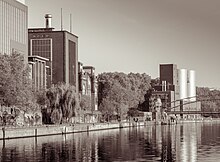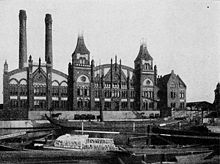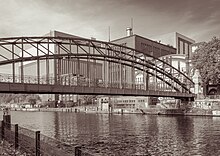Charlottenburg power plant
| Charlottenburg thermal power station | |||
|---|---|---|---|
| View of the power plant from the castle bridge | |||
| location | |||
|
|
|||
| Coordinates | 52 ° 31 '17 " N , 13 ° 18' 37" E | ||
| country |
|
||
| Data | |||
| Type | Thermal power station | ||
| Primary energy | Fossil energy | ||
| fuel | natural gas | ||
| power | 215 megawatts electrical 295 megawatts district heating |
||
| operator | Vattenfall Europe heat | ||
| Start of operations | 1900 | ||
| turbine | 3 gas turbines | ||
The thermal power station Charlottenburg (also Kraftwerk Charlottenburg ) is a thermal power station in Berlin's Charlottenburg-Wilmersdorf . It is located on the so-called Kalowswerder between Am Spreebord and Quedlinburger Straße. The Swedish energy group Vattenfall , whose subsidiary Vattenfall Europe Wärme , which belongs to the German subgroup, is responsible for its operation , has been the owner of the system, which operates on the principle of combined heat and power .
history


The city of Charlottenburg was the client and financier of the municipal power station, which went into operation on August 1, 1900 . At that time, Charlottenburg was still an independent, rapidly growing, very wealthy city that competed with Berlin . The reason for the construction by the Charlottenburg magistrate was, according to a contemporary chronicler , "the laying of a cable from the Berlin electricity works to illuminate the Kaiser Wilhelm Memorial Church , to which a number of private individuals soon applied to be connected."
In addition, the power supply for the electric tram , which replaced horse and steam trams at that time , threatened to fall victim to competition from Berlin. The councilors also planned to expand the street lighting, which the gasworks could hardly keep up with despite constantly expanding capacity. In addition, they promised a further influx of industrial companies and wealthy Berliners by offering electrical supplies.
According to the resolution, the power plant was initially to be leased for ten years to a private operating company, which in return undertook to "build an electricity plant that was sufficient to connect 25,000 light bulbs and to supply trams with the necessary electricity, as well as a cable network [...] and to build a cable bridge over the Spree to connect the network with the power plant. "
In 1899, Elektrizitäts-AG, formerly W. Lahmeyer & Co. (EAG) in Frankfurt am Main , was contracted as a leaseholder until the city took over the operation in 1910. The 28-year-old engineer Georg Klingenberg was entrusted with the technical conception and construction .
Just like the new construction of the Charlottenburg town hall , which took place a little later, the power station also demonstrated the self-confidence of the city, here with a richly furnished display facade in the “Brandenburg brick Gothic” style . The initial equipment of the power plant consisted of four water tube boilers and four tandem steam engines, two of which were intended to generate 3,000 volts three-phase current and the third 600 volts direct current; the fourth served as a reserve.
With the construction of the coal-fired power plant, EAG also built the Siemens footbridge , which led the electrical lines across the Spree to Charlottenburg, which is predominantly across the river, and also served as a pedestrian bridge. Barges supplied the power plant with coal across the Spree and were unloaded from 1911 by a mobile crane on the Spreebord. An overhead conveyor transported the fuel to a storage area. The water required to generate steam was taken from the Spree.
After a short time, the capacity of the power plant was no longer sufficient to meet the increasing demand, and a gradual expansion began. On April 1, 1902, the “number of incandescent lamps connected or their equivalent […] was 62,000, the next year 93,000 and in 1904 131,000 incandescent lamps; In addition, a single, newly installed high-voltage three-phase machine can generate 1,200 to 1,400 kilowatts for the operation of the trams . "
As early as 1912, the plant was the first of its kind to supply the Charlottenburg town hall with district heating and hot water.
After Charlottenburg was incorporated into Greater Berlin in 1920 , the power station was operated from 1922 by the Berliner Städtische Elektrizitätswerke, which was transferred to Bewag a year later . In 1925, a new switch house and high-pressure steam turbines with a total output of 72 MW were put into operation on the site. From 1926, the power plant supplied the German Opera , the Schiller Theater , the public baths in Krummen Strasse and seventy other buildings with district heating in addition to the town hall . The total length of the district heating network at that time was 2.5 km. In 1928 an imposing chimney with a height of 125 m was completed, which at the time is said to have been one of the highest chimneys in Europe.
Subsequently, the facility was modernized several times or rebuilt after being partially destroyed in the war and dismantled. In 1955, in place of the old boiler house, a red-brick reinforced concrete frame construction was built. From 1972 to 1975 a gas turbine plant was built to the west of it, almost on Sömmeringstrasse , which is still in operation today.
In 1989 the power plant on the Spreebord received a flue gas desulphurization system and in 1994 a flue gas denitrification system in a new cubic building that now dominates the entire system. In 2001 the coal-fired part of the power plant was shut down, mainly in connection with a reorganization of the (West) Berlin energy supply and the conversion to natural gas that had been planned since the 1980s .
Under the patronage of the Berlin State Monuments Office , the German Foundation for Monument Protection and Bewag announced a student competition for the conversion of the listed site on the occasion of the Open Monument Day in 2002 . The award-winning design provided for the conversion of the industrial monument into a "relaxation station", but it was not implemented. However, some parts of the building, including the machine hall from 1900, were moved into by new users after a renovation.
In 2006, the coal unloading facility on the banks of the Spree was cleared and then a riverside path was created. In September 2006, the demolition of the 125 m high chimney began, which until then clearly towered over the tower of the Charlottenburg town hall and had been a landmark that could be seen from afar for almost 80 years.
business
A part of the power plant, initially oil-powered and, since 2003, mostly natural gas-powered, with three gas turbines in a striking, orange-colored building block is still in operation. This peak-load thermal power station has been operated by Vattenfall since Bewag was sold and has an electrical output of 215 MW and a thermal output of 295 MW.
The grid connection takes place at the 110 kV high voltage level in the grid of the Vattenfall subsidiary Stromnetz Berlin GmbH.
See also
literature
- Architects and Engineers Association of Berlin (ed.), Sabine Röck et al .: Stadttechnik. (= Berlin and its buildings , Part X, Volume A (2).) Michael Imhof Verlag, Petersberg 2006, ISBN 978-3-86568-012-9 .
- Wilhelm Gundlach: History of the city of Charlottenburg. 2 volumes, Springer, Berlin 1905, archive.org .
- Historical Commission to Berlin, Helmut Engel et al. (Ed.): Historical landscape of Charlottenburg. Charlottenburg, Part 1 - The historic city. Nicolai, Berlin 1986, ISBN 3-87584-167-0 .
Web links
- Hainer Weißpflug: Charlottenburg power plant . In: Hans-Jürgen Mende , Kurt Wernicke (Hrsg.): Berliner Bezirkslexikon, Charlottenburg-Wilmersdorf . Luisenstadt educational association . Haude and Spener / Edition Luisenstadt, Berlin 2005, ISBN 3-7759-0479-4 ( luise-berlin.de - history and building description - as of October 7, 2009).
- Story and photos. In: District Lexicon Charlottenburg-Wilmersdorf on berlin.de
- Conversion of industrial monument 2003. State Monument Office Berlin
- Entry in the Berlin State Monument List with further information
Individual evidence
- ↑ Architects and Engineers Association of Berlin (ed.), Sabine Röck et al .: Stadttechnik (= Berlin and its buildings, Part X, Volume A (2)), p. 196.
- ^ Wilhelm Gundlach: History of the city of Charlottenburg. Springer, Berlin 1905, Volume 1, p. 560, Textarchiv - Internet Archive .
- ^ Wilhelm Gundlach: History of the city of Charlottenburg. Springer, Berlin 1905, Volume 1, pp. 558 f., Textarchiv - Internet Archive .
- ^ Wilhelm Gundlach: History of the city of Charlottenburg. Springer, Berlin 1905, Volume 1, p. 561, Textarchiv - Internet Archive .
- ^ Hainer Weißpflug: Klingenberg, Ernst Georg . In: Hans-Jürgen Mende , Kurt Wernicke (Hrsg.): Berliner Bezirkslexikon, Charlottenburg-Wilmersdorf . Luisenstadt educational association . Haude and Spener / Edition Luisenstadt, Berlin 2005, ISBN 3-7759-0479-4 ( luise-berlin.de - as of October 7, 2009).
- ^ Maria Curter: A power plant builder . The engineer Georg Klingenberg (1870–1925) . In: Berlin monthly magazine ( Luisenstädtischer Bildungsverein ) . Issue 8, 2000, ISSN 0944-5560 , p. 71-76 ( luise-berlin.de ).
- ^ Architects and Engineers Association of Berlin (ed.), Sabine Röck et al .: Stadttechnik (= Berlin and its buildings . Part X, Volume A (2)). Michael Imhof Verlag, Petersberg 2006, p. 198: According to this source, the authorship of the facade design is unknown.
- ^ Wilhelm Gundlach: History of the city of Charlottenburg. Springer, Berlin 1905, Volume 1, p. 562, Textarchiv - Internet Archive .
- ↑ according to feel-good brochure Berlin . (PDF) Vattenfall
- ^ Historical Commission to Berlin, Helmut Engel et al. (Ed.): Historical landscape of Charlottenburg. Charlottenburg, Part 1 - The historic city. Nicolai, Berlin 1986, ISBN 3-87584-167-0 , p. 278.
- ^ Hainer Weißpflug: Charlottenburg power station . In: Hans-Jürgen Mende , Kurt Wernicke (Hrsg.): Berliner Bezirkslexikon, Charlottenburg-Wilmersdorf . Luisenstadt educational association . Haude and Spener / Edition Luisenstadt, Berlin 2005, ISBN 3-7759-0479-4 ( luise-berlin.de - as of October 7, 2009).
- ↑ Historical Commission, p. 271
- ↑ Competition report . ( Memento of the original from September 9, 2006 in the Internet Archive ) Info: The archive link was automatically inserted and not yet checked. Please check the original and archive link according to the instructions and then remove this notice. Senate Department for Urban Development
- ↑ according to Vattenfall Europe's CHP systems ( Memento from January 17, 2007 in the Internet Archive ; PDF) Vattenfall and information from the site engineer on June 18, 2007.
- ↑ List of power plants . ( XLSX ; 681 kB) Federal Network Agency , as of March 31, 2017; accessed on November 12, 2017








